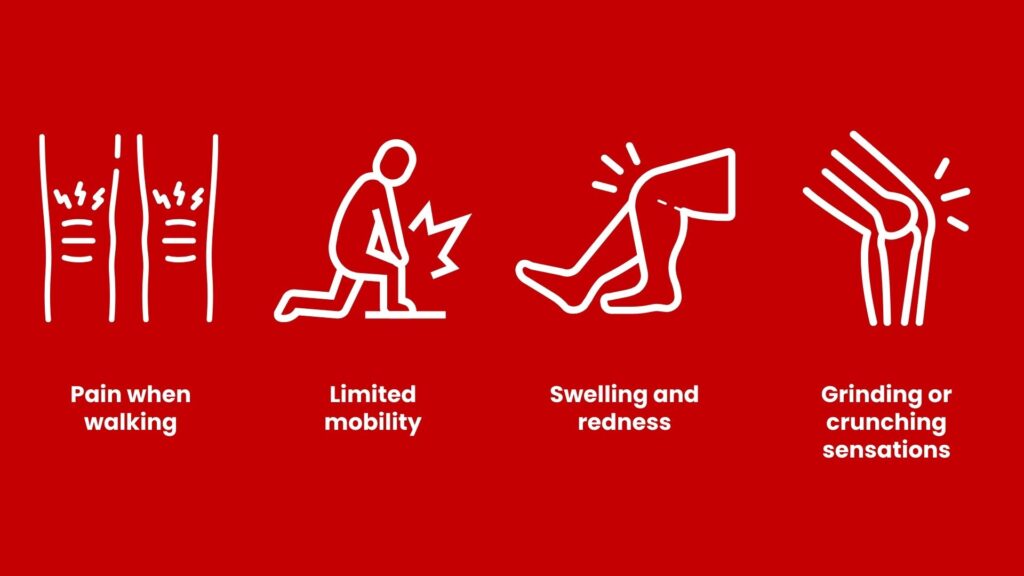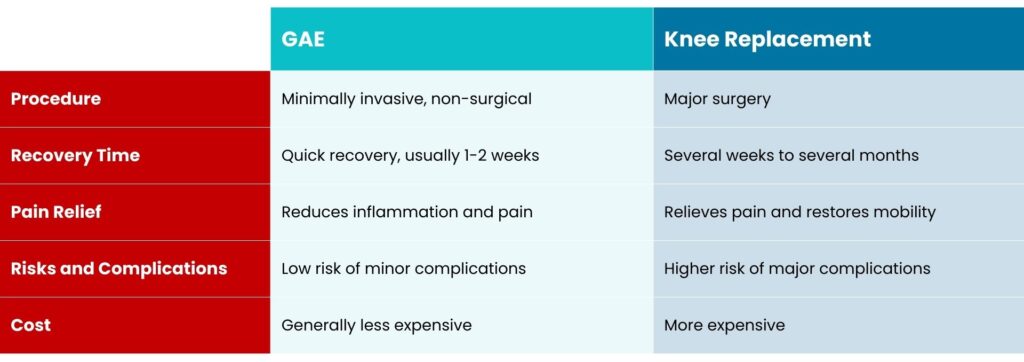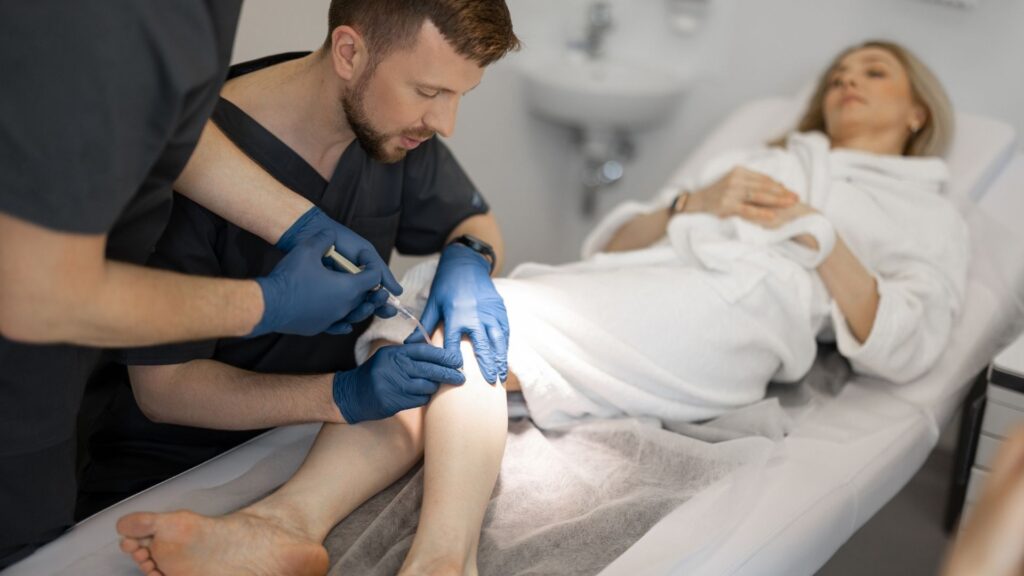Knee osteoarthritis (OA) is a degenerative joint disease that affects millions of people worldwide.
This disease causes pain and stiffness in the knee, leading to limited mobility[1].
Many of those living with knee OA will turn to knee replacement surgery to eliminate their pain.
But while knee replacement surgery is a common treatment option, did you know it’s not the only solution? There are different treatment options for knee osteoarthritis, each with its pros and cons.
It may seem difficult to determine the correct treatment option for you. But reading this article is a great first step!
Keep reading to compare knee replacement surgery to a minimally invasive treatment called genicular artery embolization – a minimally invasive procedure that has gained attention in recent years as a potential alternative to surgery[2].
Understanding Knee Osteoarthritis

Knee osteoarthritis occurs when the cartilage in your joint wears down, causing bone-on-bone contact. This consistent contact leads to pain, inflammation, and stiffness in the knee[3].
Symptoms of knee OA can range from mild to severe. Symptoms may include:

- Pain when walking, climbing stairs, or standing
- Stiffness and limited mobility
- Swelling and redness around the knee
- Grinding or crunching sensations in the joint
Genicular Artery Embolization (GAE): A Minimally Invasive Solution
Genicular artery embolization is a non-surgical procedure that involves blocking blood flow to the affected joint. This reduces inflammation and pain[4].
The procedure is performed under local anesthesia and takes about 30 minutes to an hour to complete.
During the procedure, a small catheter is inserted through a tiny incision in the skin and guided to the genicular artery, which supplies blood to the knee joint.
Once in place, the catheter releases tiny particles that block the blood flow to the joint, reducing inflammation and pain[5].
Knee Replacement Surgery: A Traditional Approach
Knee replacement surgery, also known as arthroplasty, is where the patient’s damaged joint is replaced with an artificial one.
The procedure is typically performed under general anesthesia and requires a hospital stay.
While knee replacement surgery can be effective in relieving pain and restoring mobility, it is a major surgery that carries risks and complications, such as infection, blood clots, and implant failure[6].
GAE vs. Knee Replacement: Key Differences

GAE Patient Selection
The best treatment option can vary from patient to patient.
GAE is suitable for patients with mild to moderate knee OA who have not responded to conservative treatments, such as physical therapy, medication, and injections[5].
The ideal candidate for GAE is someone who:
- Has knee pain that interferes with daily activities
- Is not good candidates for surgery due to medical conditions or age
- Prefers prefer a non-surgical, minimally invasive solution

Benefits of GAE over Knee Replacement
GAE offers several benefits over knee replacement surgery:
- There is a quicker recovery time, so you’re back to your everyday life sooner
- The risk of complications is lower.
- GAE is much less expensive than knee replacement.
- The procedure is minimally invasive.
Long-Term Outcomes
Studies have shown that GAE can provide long-term pain relief and improved quality of life for patients with knee OA[3].
A study published in the Journal of Clinical Medicine found that GAE resulted in significant improvements in pain and function at 12 months[7].
So you don’t need to turn to surgery to find lasting relief from knee pain!
Conclusion
GAE is a viable alternative to knee replacement surgery for patients with knee OA. With its minimally invasive approach, quick recovery time, and lower risk of complications, GAE is an attractive option for those seeking a non-surgical solution.
While knee replacement surgery can be effective, it’s essential to consider the risks and benefits of each procedure before making a decision.
At Centers for Knee Pain, our experts know the ins and outs of both procedures and can effectively evaluate your condition and medical history to determine the best long-term knee pain treatment plan.
If you’re ready to take the first steps toward a life free of knee pain, schedule a consultation with one of our experienced doctors at one of our five locations today!
Still wondering if GAE is right for you? Take our FREE knee quiz and learn more!
Citations
- Landers, S., Hely, A., Harrison, B., Maister, N., Hely, R., Lane, S., Gill, S., & Page, R. (2017). Protocol for a single-centre, parallel-arm, randomised controlled superiority trial evaluating the effects of transcatheter arterial embolisation of abnormal knee neovasculature on pain, function and quality of life in people with knee osteoarthritis. BMJ Open, 7. https://doi.org/10.1136/bmjopen-2016-014266
- O’Brien, S., Blakeney, W., & Soares, J. (2024). Selective Genicular Artery Embolization in the Management of Osteoarthritic Knee Pain—A Narrative Review. Journal of Clinical Medicine, 13. https://doi.org/10.3390/jcm13113256
- Badii, M., Parhar, D., Badii, S., & Liu, D. (2023). AB0503 GENICULAR ARTERY EMBOLIZATION IN THE MANAGEMENT OF PERSISTENT JUVENILE IDIOPATHIC ARTHRITIS OF THE KNEE: A CASE REPORT. Annals of the Rheumatic Diseases. https://doi.org/10.1136/annrheumdis-2023-eular.843
- Russu, O., Bloj, F., Feier, A., Vunvulea, V., Mogoş, Ş., Predescu, V., & Pop, T. (2022). At the Edge of Orthopaedics: Initial Experience with Transarterial Periarticular Embolization for Knee Osteoarthritis in a Romanian Population. Journal of Clinical Medicine, 11. https://doi.org/10.3390/jcm11216573
- Femia, M., Pittino, C., Fumarola, E., Tramarin, M., Papa, M., Giurazza, F., Francioso, A., Fior, D., Moramarco, L., Antonini, G., Vercelli, R., & Cariati, M. (2024). Genicular Artery Embolization: A New Tool for the Management of Refractory Osteoarthritis-Related Knee Pain. Journal of Personalized Medicine, 14. https://doi.org/10.3390/jpm14070686
- Ko, M. S., Choi, C. H., Yoon, H. K., Yoo, J. H., Oh, H. C., Lee, J. H., & Park, S. H. (2021). Risk factors of postoperative complications following total knee arthroplasty in Korea: A nationwide retrospective cohort study. Medicine, 100(48), e28052. https://doi.org/10.1097/MD.0000000000028052
- Little, M. W., Gibson, M., Briggs, J., Speirs, A., Yoong, P., Ariyanayagam, T., Davies, N., Tayton, E., Tavares, S., MacGill, S., McLaren, C., & Harrison, R. (2021). Genicular Artery Embolization in Patients with OsteoarthrItis of the Knee (GENESIS) Using Permanent Microspheres: Interim Analysis. Cardiovascular and interventional radiology, 44(6), 931–940. https://doi.org/10.1007/s00270-020-02764-3




